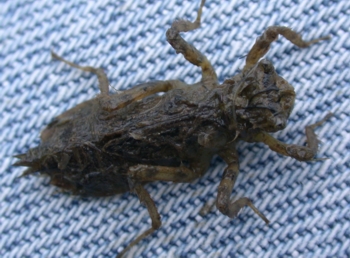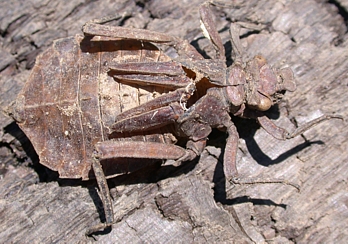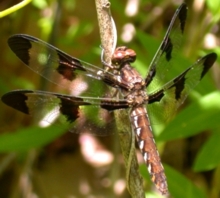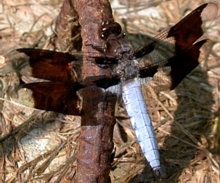|
|
ARTHROPODS:
Insects»
Spiders»
Centipedes»
Millipedes»
Sowbugs»
Harvestmen»
Mites
& Ticks»
Scorpions»
Identification
Tips»
About
the Critter Files»
Links» |
|
|
|
 |
DRAGONFLIES
Critter
Files/Insects/Dragonflies
By Blake Newton
University of Kentucky Department of Entomology |
| |
|
| Common
Kentucky Dragonflies: |
| |
| TAXONOMY |
KINGDOM: Animalia
| PHYLUM: Arthropoda | CLASS: Insecta | ORDER: Odonata
SUBORDER: Anisoptera (dragonflies) |
| |
WHAT
IS A DRAGONFLY?
LIFE CYCLE
ECOLOGY
PEST STATUS
COMMON KENTUCKY DRAGONFLIES
COLLECTING & PHOTOGRAPHY
DRAGONFLY FACTS
MYTHS, LEGENDS, AND FOLKLORE |
| |
| WHAT
IS A DRAGONFLY? |
|
| Like all insects, dragonflies
have 6 legs, 2 antennae, and 3 body parts. Adult dragonflies
have 2 pairs of wings, chewing mouthparts, and large compound eyes.
Dragonfly antennae are very short, and cannot be seen without
close inspection. Dragonflies look similar to damselflies,
but dragonflies are unable to fold their wings over their bodies,
whereas most damselflies hold their wings over their bodies when they
are not flying. Young dragonflies (called "nymphs"
or "naiads") are fully aquatic. They resemble adults
except that they are wingless. |
|
| SIZE:
Adults can be more than 3" long; naiads 2". |
| |
| LIFE
CYCLE |
|
Dragonflies
have incomplete metamorphosis. After hatching from eggs, dragonfly
naiads live and grow underwater. When they are ready to become
winged adults, naiads climb to the surface of the water, usually
on a plant stem or an exposed rock, and shed their skins. Adults
are active in the spring, summer, or fall, depending on the species.
Dragonflies mate in mid-air. Most female dragonflies
dip their abdomens into water to deposit eggs; others insert the
eggs into the stems of underwater plants. |
| |
|
 Dragonfly Naiad,
family Libellulidae (B. Newton, 2004)
Dragonfly Naiad,
family Libellulidae (B. Newton, 2004) |
|
 Shed skin of
a dragonfly naiad, family Gomphidae (B. Newton, 2006)
Shed skin of
a dragonfly naiad, family Gomphidae (B. Newton, 2006) |
| |
| ECOLOGY |
|
Immature
and adult dragonflies are important predators in pond and stream
ecosystems. The aquatic naiads feed voraciously on minnows,
tadpoles, aquatic insects, and other small, live prey. Dragonfly
naiads are primarily ambush predators: they find a strategic spot
on an underwater leaf or under a rock. When a victim gets
close, the naiad snags it with harpoon-like extendable jaws. In
turn, dragonfly naiads are eaten by many fish species.

Jaws of a dragonfly naiad, family Libellulidae (B.
Newton, 2004)
Adult
dragonflies are also predators. They are fantastic fliers,
able to swerve, dive, and quickly change directions to catch flying
insects in mid-air.
Dragonfly
naiads are a food source for fish, aquatic spiders, and other aquatic
insects (including larger dragonfly naiads). Adult dragonflies
are sometimes eaten by birds and web-building spiders. |
| |
| PEST
STATUS |
|
Dragonflies
are not considered pests. They are typically considered beneficial
because they eat mosquitoes and other pests. |
| |
| COMMON
KENTUCKY DRAGONFLIES |
|
| We
have many common dragonfly species in Kentucky. They all have
similar behavior, but some are found near ponds, others are more common
near streams and rivers, depending on the species. Some of the
most common types are pictured below. |
|
|
|
DARNERS
FAMILY: Aeshnidae
Pictured below is the
Green Darner, Anax junius. Darners
are some of the most commonly encountered dragonflies in Kentucky, especially
near ponds. They are also among our largest dragonflies, at over
3". Green darners have clear wings, a green thorax, and
an abdomen that is often bright blue. A few other types of
darners are also found in Kentucky. Most are similar in size
and appearance. |
| |
| |
|
Green
Darner (B. Newton, 2002) |
|
|
|
COMMON
SKIMMERS
FAMILY: Libellulidae
Kentucky is home to
several common species of Common Skimmers. Common
skimmers are fast fliers, and they are usually seen zipping up and
down the sides of streams and creeks. Skimmers often have
bold white-and-black or blue-and-black patterns on their bodies
and wings. Most common skimmers have bodies between 1 - 2
½" long. The nymph of a common
skimmer dragonfly is pictured above in the Life Cycle section.
Pictured below are the
female (left) and male (right) Common Whitetail Skimmer,
Libellula lydia. This species is very common in Kentucky. |
| |
 Female Whitetail
Skimmer (B. Newton, 2003)
Female Whitetail
Skimmer (B. Newton, 2003) |
 Male Whitetail
Skimmer (B. Newton, 2003)
Male Whitetail
Skimmer (B. Newton, 2003) |
| |
|
| Common skimmers
in the genus Celithemis are usually called "Pennants."
Pictured below is a female Banded Pennant,
Celithemis fasciata. It was about 1.5" long. |
 Female Banded
Pennant (B. Newton, 2003)
Female Banded
Pennant (B. Newton, 2003) |
| |
|
|
|
|
GREEN-EYED
SKIMMERS
FAMILY:
Corduliidae
Green-Eyed Skimmers,
also known as "emeralds," are often found near standing
water (ponds and marshes). Pictured below is a green-eyed skimmer
in the genus Epitheca. Dragonflies in this genus are
usually called "Baskettails." The one below was photographed
near a small lake in Rowan County, KY, and it was about 2" long. |
| |
 Baskettail, a
type of Green-Eyed Skimmer (B. Newton, 2006)
Baskettail, a
type of Green-Eyed Skimmer (B. Newton, 2006) |
|
|
|
|
|
| ABOVE:
Close-up of a Baskettail dragonfly wing. Dragonfly families
and species are often distinguished by the pattern of veins in their
wings. Green-Eyed Skimmers belong to the dragonfly superfamily
Libelluloidea, which includes several families of Skimmers. All
skimmers can be distinguished from other dragonflies by the shape
of the "triangles" in the front and rear wings: the triangles
on a skimmer will be of a dissimilar size and shape. To distinguish
green-eyed skimmers (family Corduliidae) from other skimmers, look
at the "anal loop" in the rear wing. In green-eyed
skimmers, the anal loop will be peninsular in shape, but not boot-like
(as with common skimmers). Roll mouse over image to see the
"triangles" (in white) and the "anal loop" (in
pink) which are characteristic of the dragonfly family Corduliidae
(B. Newton, 2006). |
|
|
| COLLECTING
& PHOTOGRAPHY |
|
Dragonfly naiads and
adults are a challenge to collect. You must have an aerial
insect net (and super-human patience) if you want any hope of catching
a dragonfly on the wing. Catching naiads usually requires
an aquatic insect net. Try dipping in parts of ponds and streams
where a lot of aquatic vegetation is growing.
Even if you just want
a picture, it's difficult to get close to a dragonfly. Dragonflies
are beautiful photography subjects, but their quickness makes it
a challenge to snap a good picture. Make sure to use a fast
film speed in bright daylight. Also: try looking for dragonflies
early on cool summer mornings - they may be found "warming
up" on plants, and will not be so quick to fly away.
Dragonfly naiads are
a fun addition to a freshwater aquarium (as long as you don't mind
them eating your expensive tropical fish!). Read about insects
in the home aquarium in our on-line article.
|
| |
| DRAGONFLY
FACTS |
|
Dragonflies can beat
their four wings at different speeds and hold them at different
angles. This allows them to fly in any direction and also to hover
in place like a helicopter.
While most aquatic insects
have gills on the outside of their abdomens, dragonfly naiads have
their gills on the inside. They use abdominal muscles to move
water into and out of their abdomens to breath. This same
action can also be used to "jet propel" a dragonfly naiad
away from danger.
Because fish like to
eat dragonflies, fishermen have special lures that are designed
to look and move like dragonfly naiads. Fly fishermen use
lures designed to fly through the air like adult dragonflies.
|
| |
| MYTHS
- LEGENDS - FOLKLORE |
|
People once believed
that dragonflies were able to "sew up" a persons lips
or ears. This may be the reason why some dragonflies are called
"darners"; a "darner" is also a kind of knitting
needle.
Kentuckian Earlane Cox has often heard dragonflies referred to as "snake feeders" or "snake doctors." Apparently, these nick names stem from the belief that dragonflies caught insects for snakes or otherwise helped care for snakes, including helping to raise baby snakes. |
| |
Original document: 25 May 2004
Last updated: 16 Aug 2008
Photos courtesy R.
Bessin and B. Newton, University of Kentucky
The Kentucky Critter Files are maintained by Blake Newton, Department
of Entomology, University of Kentucky.
Contact: blaken@uky.edu |
|

